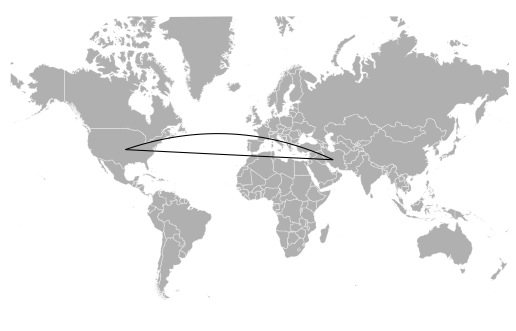I think what you're looking for are 'Bezier' curves (check wikipedia for a thorough explanation on the topic https://en.wikipedia.org/wiki/Bézier_curve). In R, this is implemented using a number of different packages or you can create your own like the following:
#Load dependencies
library(ggplot2)
library(maptools)
library(geosphere)
#Identify countries of interest and their centroids (see https://www.cia.gov/library/publications/the-world-factbook/fields/2011.html)
countries <- data.frame(
Country=c("United States", "Iran"),
ISO3=c("USA","IRN"),
latitude=c(38,32),
longitude=c(-97,53),
stringsAsFactors=FALSE)
#Get world map
data(wrld_simpl)
map.data <- fortify(wrld_simpl)
#Set up map
draw.map <- function(ylim=c(0,85)) {
ggplot(map.data, aes(x=long, y=lat, group=group)) +
geom_polygon(fill="grey") +
geom_path(size=0.1,color="white") +
coord_map("mercator", ylim=c(-60,120), xlim=c(-180,180)) +
theme(line = element_blank(),
text = element_blank())
}
#Identify the points of the curve
p1 <- c(countries$longitude[1],
countries$latitude[1])
p2 <- c(countries$longitude[2],
countries$latitude[2])
#Create function to draw Brezier curve
bezier.curve <- function(p1, p2, p3) {
n <- seq(0,1,length.out=50)
bx <- (1-n)^2 * p1[[1]] +
(1-n) * n * 2 * p3[[1]] +
n^2 * p2[[1]]
by <- (1-n)^2 * p1[[2]] +
(1-n) * n * 2 * p3[[2]] +
n^2 * p2[[2]]
data.frame(lon=bx, lat=by)
}
bezier.arc <- function(p1, p2) {
intercept.long <- (p1[[1]] + p2[[1]]) / 2
intercept.lat <- 85
p3 <- c(intercept.long, intercept.lat)
bezier.curve(p1, p2, p3)
}
arc3 <- bezier.arc(p1,p2)
bezier.uv.arc <- function(p1, p2) {
# Get unit vector from P1 to P2
u <- p2 - p1
u <- u / sqrt(sum(u*u))
d <- sqrt(sum((p1-p2)^2))
# Calculate third point for spline
m <- d / 2
h <- floor(d * .2)
# Create new points in rotated space
pp1 <- c(0,0)
pp2 <- c(d,0)
pp3 <- c(m, h)
mx <- as.matrix(bezier.curve(pp1, pp2, pp3))
# Now translate back to original coordinate space
theta <- acos(sum(u * c(1,0))) * sign(u[2])
ct <- cos(theta)
st <- sin(theta)
tr <- matrix(c(ct, -1 * st, st, ct),ncol=2)
tt <- matrix(rep(p1,nrow(mx)),ncol=2,byrow=TRUE)
points <- tt + (mx %*% tr)
tmp.df <- data.frame(points)
colnames(tmp.df) <- c("lon","lat")
tmp.df
}
arc4 <- bezier.uv.arc(p1,p2)
bezier.uv.merc.arc <- function(p1, p2) {
pp1 <- p1
pp2 <- p2
pp1[2] <- asinh(tan(p1[2]/180 * pi))/pi * 180
pp2[2] <- asinh(tan(p2[2]/180 * pi))/pi * 180
arc <- bezier.uv.arc(pp1,pp2)
arc$lat <- atan(sinh(arc$lat/180 * pi))/pi * 180
arc
}
arc5 <- bezier.uv.merc.arc(p1, p2)
d <- data.frame(lat=c(32,38),
lon=c(53,-97))
draw.map() +
geom_path(data=as.data.frame(arc5),
aes(x=lon, y=lat, group=NULL)) +
geom_line(data=d, aes(x=lon, y=lat, group=NULL),
color="black", size=0.5)
![enter image description here]()
Also see http://dsgeek.com/2013/06/08/DrawingArcsonMaps.html for a more thorough explanation of Bezier curves using ggplot2

